Updated Monday, Dec. 14 at 14:38 EST
TAKEAWAY; As our work with the Philadelphia Inquirer/Daily News/philly.com continues in an evolutionary way, we take pride in showcasing an example from this past week which displays the type of print/online team efforts worth analyzing. PLUS: The face on page one of the Italian newspapers today
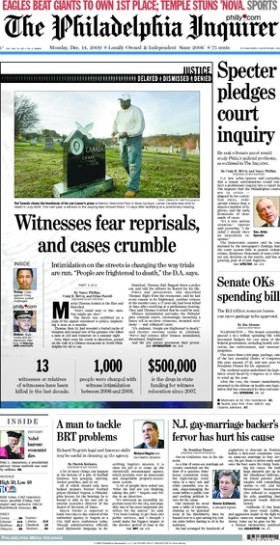
Front page of The Philadelphia Inquirer, with promotions to multimedia package of story in philly.com
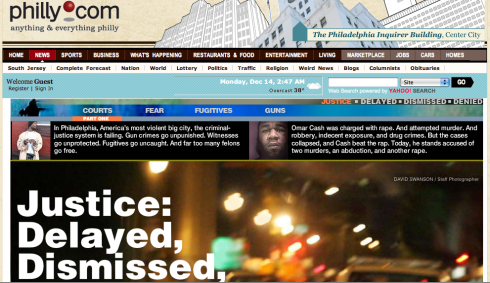
Go to www.philly.com to see how different layers of the series are presented in multimedia format
As the series’ introduction points out, Philadelphia is America’s most violent big city, the criminal justice is failing, gun crimes go unpunished, witnesses go unprotected, fugitives go uncaught, and far too many felons go free.
This is not only the backdrop of a possible Hollywood blockbuster movie. For Philadelphians, it is a sad, daily reality. For The Philadelphia Inquirer, it is an opportunity to showcase the type of investigative, public service journalism that has earned it 18 Pulitzer Prizes.
For Reed Reibstein (Yale University ‘11), our year-round intern, and for me, the series, and its fantastically well crafted storytelling across various platforms, indicates enormous progress in the newsroom’s ability to coordinate content between print/digital platforms. This, as you know, has been a centerpiece of our internal discussions with the editors at the Inquirer/Daily News/philly.com.
With the Inquirer’s excellent brand of investigative journalism, it is only a matter of centering on the story, not the platforms, that will yield the type of results we now see with this presentation. This is the first part of a four-part investigation titled Crisis in the Courts, about the problems in the legal system that have made Philadelphia the most crime-ridden big city in America.
Reed discovered the story and its treatment while looking at the Inquirer’s front page online Sunday morning. He immediately sent it to me. Reed has been my copilot all along in our effort to help the Inquirer, an iconic American newspaper, get back on its feet, emerge from bankruptcy and flex its muscles with its strength: the excellent quality of its journalism, as shown in this series of articles. Here’s how Reed described his discovery:
The presentation on the front page is nice, but what is truly wonderful is the online presentation (teased twice on the front page): http://www.philly.com/philly/news/special_packages/78794487.html. Beginning with a gripping investigative story that details how witnesses in Philadelphia are often threatened or killed to prevent their testifying, the print and online team have contributed video and audio featuring interviews with the criminals and their victims, graphics illustrating Philadelphia’s crime rate, and photo slideshows of past murders—overall a big, interactive presentation. And this is just for part one!
Indeed, this is certainly a very encouraging sign. For newspapers everywhere, a true example of why, as I often say, these are the best of times for all of us in the storytelling business. Each platform here has been utilized to do what it can do best.
The narrative in the printed Inky still pulls a heavy punch——not much different from the type of writing that has characterized The Philadelphia Inquirer for over a century.
And that, I think, is worth preserving.
Bravo to the team.
The Philadelphia Story will continue.
For previous blog posts about our work with The Philadelphia Inquirer, Daily News and philly.com:
https://www.garciamedia.com/blog/articles/in_philadelphia_moving_philly.com_to_the_top_of_the_page/
https://www.garciamedia.com/blog/articles/the_philadelphia_story_entry_6_we_present_positive_reactions/
The Face in the News
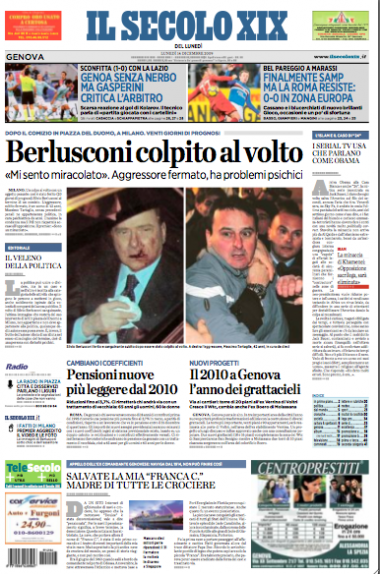
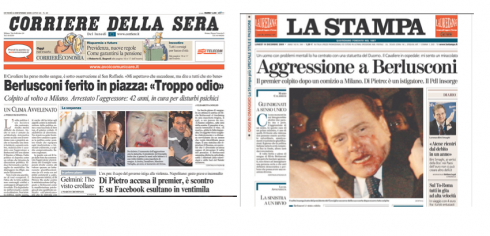
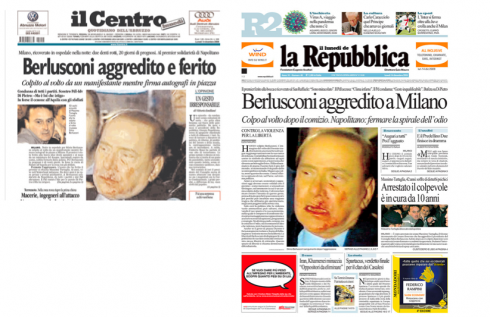
Sampling of Italian newspapers today, displaying news of the attack Sunday on Silvio Berlusconi
I was curious to take a look at several Italian newspapers to see how their front pages covered the incident Sunday in which an assailant wielding a model of Milan’s cathedral broke Italian Prime Minister Silvio Berlusconi’s nose. It was reassuring to see that the Italian media were united in their condemnation of the incident.
Even in such titles as Il Corriere della Sera, the country’s leading daily, normally not pro Berlusconi, columnist Pierluigi Battisti wrote that a primitive version of politics had become dominant “with a crescendo of hostility that touches on an anthropological war between two Italys that hate each other, and are incapable of talking.”
I display here other front pages from leading Italian dailies. The image is pretty much the same one I saw in many other European dailies: the bloodied face of the Prime Minister.

What The Taxi Driver Said is a recurring feature
I spend a sizeable amount of my time riding taxis across the globe.
Anyone who rides taxis knows that taxi drivers are among the most outspoken and opinionated members of their communities. This I have found to be true across six continents.
I learn much from taxi drivers, and I usually see them as a thermometer of their societies.
Today in Amsterdam, I gave my taxi driver directions of where to take me——a newspaper office, of course.
“Oh, you are in the newspaper business,” he said with a smile, big blue eyes looking at me thru the rearview mirror.
“Yes, sir, I am,” I responded.
“What’s going to happen to newspapers?” he asked, then proceeded to answer his own question.
“I think that just a few will survive. If you are thinking green, like many people are these days, you don’t want trees sacrificed to make way for paper, so that is one reason not to buy the newspaper. And then there is the online reading, that so many people do. You agree?”
I said that it was, indeed, difficult times for newspapers everywhere.
But, just before I got out of the taxi, I saw that he had a copy of the one newspaper I was coming to visit folded on the passenger seat next to him.
“OH, but you still read a newspaper, I see one here,” I said, acting surprised.
“Yes, I do. I like my newspaper, the feel of it, and I don’t necessarily like to read stories on my mobile phone”.
By then we had reached our destination.
TheMarioBlog post #438